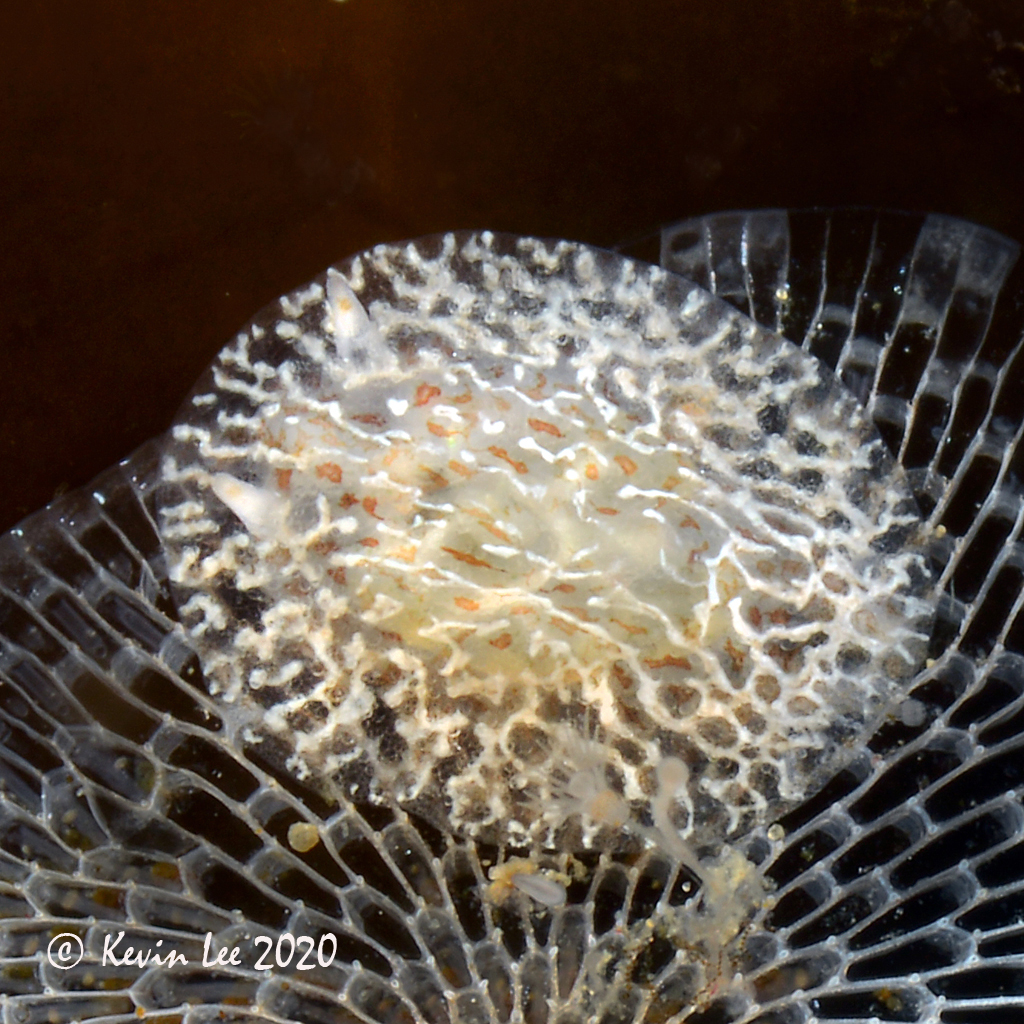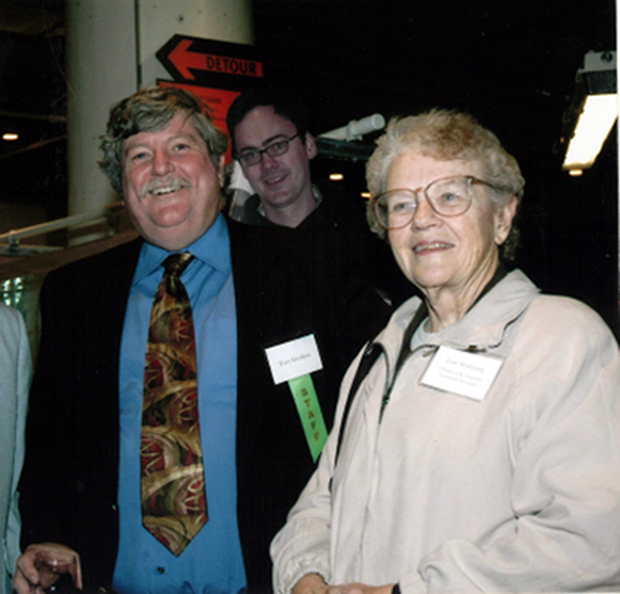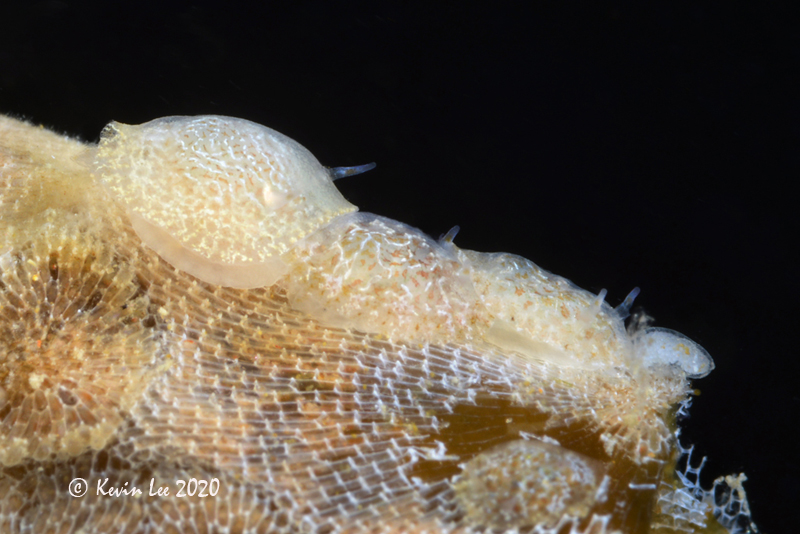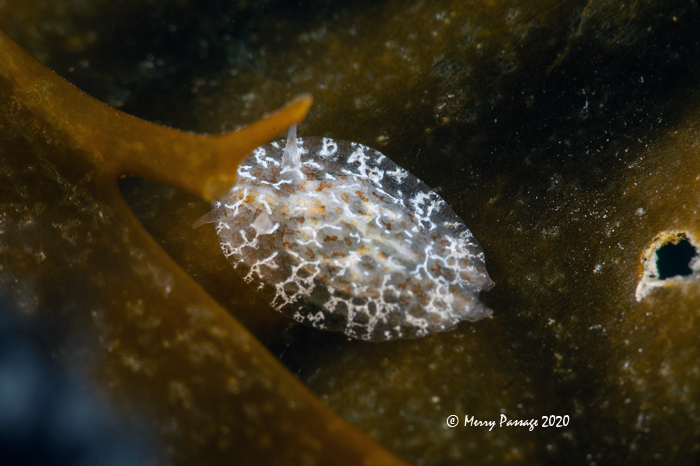 |
Image courtesy of Kevin Lee
Pt. Vincente, Little Reef, Palos Verdes, California
|
Terry and Joan at Academy Function Image courtesy of Terry Gosliner  |
Corambe steinbergae (Lance, 1962) Dave Behrens and I just received the sad news that Joan Steinberg passed away on August 26th. Joan was largely an unsung heroine of West Coast nudibranchs. She was born in San Francisco and at the age of 4 first visited the California Academy of Sciences. As a teenager she joined the Academy's student section and was already an avid naturalist. She then went to U.C. Berkeley and received her Bachelor's in Zoology. That is where she first fell in love with nudibranchs and discovered Aglaja nana I first met Joan when I was 14 and first became seriously interested in nudibranchs. Joan was a great mentor and had published on California nudibranchs in the 1950s and 1960s. She aided Olive MacFarland in completing Frank MacFarland's monograph on nudibranchs. She invited me to go tidepooling with her in Bolinas and took me to Duxbury Reef. Her joy and enthusiasm were manifest when we came across our first Hermissenda, two minutes after stepping on to the reef. I kept in touch with Joan throughout the years and she was always thrilled with the new discoveries were making about new California nudibranchs. Joan was a elementary and middle school teacher for 34 years, which certainly qualifies her for sainthood, in my mind. After retirement, Joan volunteered at the Academy in the invertebrate zoology department and like her mother before her, became an Academy docent, again teaching young kids about sciences. A retired teacher is always a teacher. She was a gracious lady who gave generously of her time and resources and shared her deep knowledge with anyone. We will miss her a great deal. California Academy of Sciences Golden Gate Park San Francisco, Calif Oct., 2020 |
Corambe steinbergae, on bryozoa food source, Membranipora
Garden Spot, Palos Verdes, California
Image courtesy of Kevin Lee
 |
Although Joan was a Fulbright Scholar, she never really tried to keep up with the "publish or perish" scholars of her day. In fact she published only a handful of papers in her career, two describing new species. In 1960 she coauthored a paper with Meredith Jones describing Aglaja nana, a small cephalopod, with was later synonymized with Melanochalmys diomedea, from the murky shallows of San Francisco Bay. The second, published in 1963, described the now resurrected Diaulula odonoghuei Steinberg 1963, a pseudocryptic cousin of Diaulula sandiegensis (see Lindsay et al, 2016). All courtesy of Bill Rudman's Sea Slug forum. Joan was of great help to me as I began to study sea slugs. She took me by the hand and lead me, most challengingly, through the writing of my first two publications, eventually acting as my technical editor for the first rendition of Pacific Coast Nudibranchs, the book I would dedicate to her and my then wife. Friend and Brancher, Jim Lance, would honor Joan for her labors with this group of critters, by naming Corambe steinbergae after her. Quite the opposite of Joan's impacts of our knowledge of this group along the California coast, Corambe steinbergae is a minute, and highly cryptic dorid nudibranch living on kelp fronds of the giant kelp, Macrocystis integrefolia, encrusted with the slug's food, the encrusting bryozoan, Membranopora. This species has undergone numerous generic placement changes, including Doridella, Suhinia and Paracorambe, but is now safely back in Corambe.
|
Palos Verdes, California
Image courtesy of Merry Passage
 |
The notal surface of this species is covered with a pattern of white lines, forming a pattern that resembles the bryozoan. The gill is hidden posteriorly, under the mantle, not in a notch like other members of this family. With nothing to indicate it is a nudibranch except the rhinophores, this species has eluded most slug-o-philes for years. The next time you are walking the beach or diving and come across giant kelp covered with Membranopora, look for low gelatinous bumps on the bryozoans in conjunction with its distinctive egg mass. If you find any of the two, you likely have come across Steinberg's Corambe. References:
Lance, J. R. (1962) A new Stiliger and a new Corambella (Mollusca: Opisthobranchia) from the northwestern Pacific. The Veliger, 5(1): 33-38, pl. 6. Sammamish, WA 98074 Oct., 2020
Send Dave Behrens email at davidwbehrens@gmail.com |
